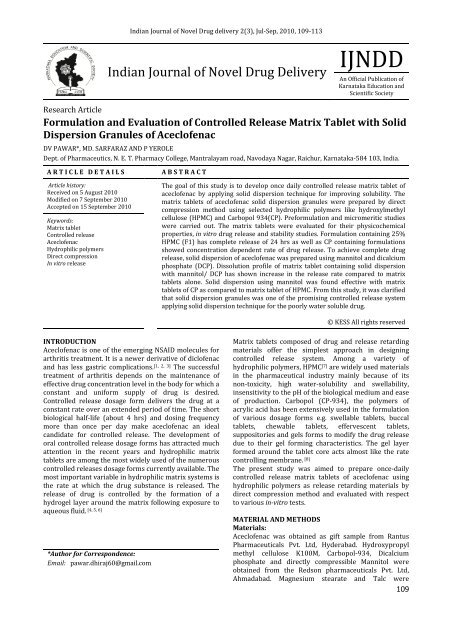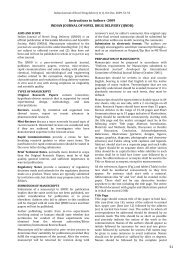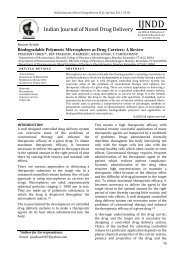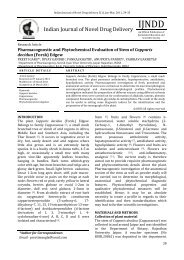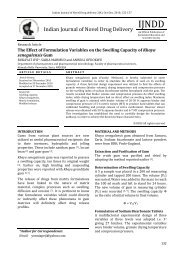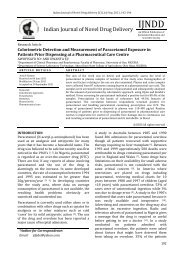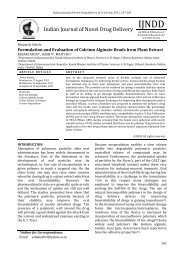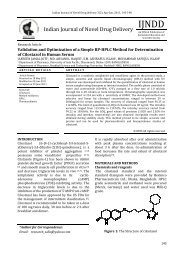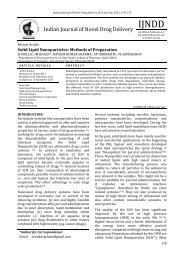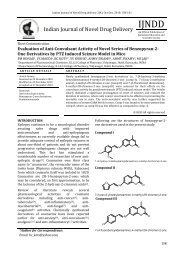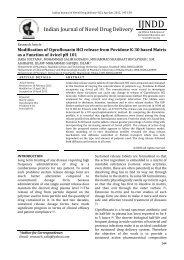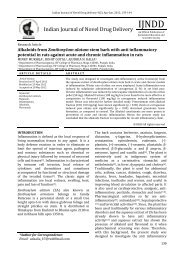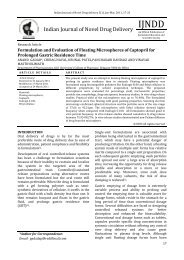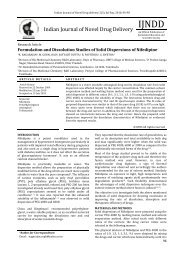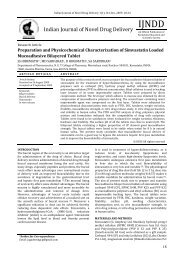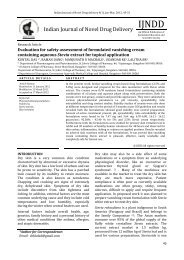Formulation and Evaluation of Controlled Release Matrix Tablet with ...
Formulation and Evaluation of Controlled Release Matrix Tablet with ...
Formulation and Evaluation of Controlled Release Matrix Tablet with ...
Create successful ePaper yourself
Turn your PDF publications into a flip-book with our unique Google optimized e-Paper software.
Indian Journal <strong>of</strong> Novel Drug delivery 2(3), Jul-Sep, 2010, 109-113<br />
Indian Journal <strong>of</strong> Novel Drug Delivery<br />
IJNDD<br />
An Official Publication <strong>of</strong><br />
Karnataka Education <strong>and</strong><br />
Scientific Society<br />
Research Article<br />
<strong>Formulation</strong> <strong>and</strong> <strong>Evaluation</strong> <strong>of</strong> <strong>Controlled</strong> <strong>Release</strong> <strong>Matrix</strong> <strong>Tablet</strong> <strong>with</strong> Solid<br />
Dispersion Granules <strong>of</strong> Acecl<strong>of</strong>enac<br />
DV PAWAR*, MD. SARFARAZ AND P YEROLE<br />
Dept. <strong>of</strong> Pharmaceutics, N. E. T. Pharmacy College, Mantralayam road, Navodaya Nagar, Raichur, Karnataka-584 103, India.<br />
A R T I C L E D E T A I L S<br />
Article history:<br />
Received on 5 August 2010<br />
Modified on 7 September 2010<br />
Accepted on 15 September 2010<br />
Keywords:<br />
<strong>Matrix</strong> tablet<br />
<strong>Controlled</strong> release<br />
Acecl<strong>of</strong>enac<br />
Hydrophilic polymers<br />
Direct compression<br />
In vitro release<br />
A B S T R A C T<br />
The goal <strong>of</strong> this study is to develop once daily controlled release matrix tablet <strong>of</strong><br />
acecl<strong>of</strong>enac by applying solid dispersion technique for improving solubility. The<br />
matrix tablets <strong>of</strong> acecl<strong>of</strong>enac solid dispersion granules were prepared by direct<br />
compression method using selected hydrophilic polymers like hydroxylmethyl<br />
cellulose (HPMC) <strong>and</strong> Carbopol 934(CP). Preformulation <strong>and</strong> micromeritic studies<br />
were carried out. The matrix tablets were evaluated for their physicochemical<br />
properties, in vitro drug release <strong>and</strong> stability studies. <strong>Formulation</strong> containing 25%<br />
HPMC (F1) has complete release <strong>of</strong> 24 hrs as well as CP containing formulations<br />
showed concentration dependent rate <strong>of</strong> drug release. To achieve complete drug<br />
release, solid dispersion <strong>of</strong> acecl<strong>of</strong>enac was prepared using mannitol <strong>and</strong> dicalcium<br />
phosphate (DCP). Dissolution pr<strong>of</strong>ile <strong>of</strong> matrix tablet containing solid dispersion<br />
<strong>with</strong> mannitol/ DCP has shown increase in the release rate compared to matrix<br />
tablets alone. Solid dispersion using mannitol was found effective <strong>with</strong> matrix<br />
tablets <strong>of</strong> CP as compared to matrix tablet <strong>of</strong> HPMC. From this study, it was clarified<br />
that solid dispersion granules was one <strong>of</strong> the promising controlled release system<br />
applying solid dispersion technique for the poorly water soluble drug.<br />
© KESS All rights reserved<br />
INTRODUCTION<br />
Acecl<strong>of</strong>enac is one <strong>of</strong> the emerging NSAID molecules for<br />
arthritis treatment. It is a newer derivative <strong>of</strong> dicl<strong>of</strong>enac<br />
<strong>and</strong> has less gastric complications. [1, 2, 3] The successful<br />
treatment <strong>of</strong> arthritis depends on the maintenance <strong>of</strong><br />
effective drug concentration level in the body for which a<br />
constant <strong>and</strong> uniform supply <strong>of</strong> drug is desired.<br />
<strong>Controlled</strong> release dosage form delivers the drug at a<br />
constant rate over an extended period <strong>of</strong> time. The short<br />
biological half-life (about 4 hrs) <strong>and</strong> dosing frequency<br />
more than once per day make acecl<strong>of</strong>enac an ideal<br />
c<strong>and</strong>idate for controlled release. The development <strong>of</strong><br />
oral controlled release dosage forms has attracted much<br />
attention in the recent years <strong>and</strong> hydrophilic matrix<br />
tablets are among the most widely used <strong>of</strong> the numerous<br />
controlled releases dosage forms currently available. The<br />
most important variable in hydrophilic matrix systems is<br />
the rate at which the drug substance is released. The<br />
release <strong>of</strong> drug is controlled by the formation <strong>of</strong> a<br />
hydrogel layer around the matrix following exposure to<br />
aqueous fluid.<br />
[4, 5, 6]<br />
*Author for Correspondence:<br />
Email: pawar.dhiraj60@gmail.com<br />
<strong>Matrix</strong> tablets composed <strong>of</strong> drug <strong>and</strong> release retarding<br />
materials <strong>of</strong>fer the simplest approach in designing<br />
controlled release system. Among a variety <strong>of</strong><br />
hydrophilic polymers, HPMC [7] are widely used materials<br />
in the pharmaceutical industry mainly because <strong>of</strong> its<br />
non-toxicity, high water-solubility <strong>and</strong> swellability,<br />
insensitivity to the pH <strong>of</strong> the biological medium <strong>and</strong> ease<br />
<strong>of</strong> production. Carbopol (CP-934), the polymers <strong>of</strong><br />
acrylic acid has been extensively used in the formulation<br />
<strong>of</strong> various dosage forms e.g. swellable tablets, buccal<br />
tablets, chewable tablets, effervescent tablets,<br />
suppositories <strong>and</strong> gels forms to modify the drug release<br />
due to their gel forming characteristics. The gel layer<br />
formed around the tablet core acts almost like the rate<br />
controlling membrane. [8]<br />
The present study was aimed to prepare once-daily<br />
controlled release matrix tablets <strong>of</strong> acecl<strong>of</strong>enac using<br />
hydrophilic polymers as release retarding materials by<br />
direct compression method <strong>and</strong> evaluated <strong>with</strong> respect<br />
to various in-vitro tests.<br />
MATERIAL AND METHODS<br />
Materials:<br />
Acecl<strong>of</strong>enac was obtained as gift sample from Rantus<br />
Pharmaceuticals Pvt. Ltd, Hyderabad. Hydroxypropyl<br />
methyl cellulose K100M, Carbopol-934, Dicalcium<br />
phosphate <strong>and</strong> directly compressible Mannitol were<br />
obtained from the Redson pharmaceuticals Pvt. Ltd,<br />
Ahmadabad. Magnesium stearate <strong>and</strong> Talc were<br />
109
DV Pawar et al / Indian Journal <strong>of</strong> Novel Drug Delivery 2(3), Jul-Sep, 2010, 109-113<br />
obtained from the S.D. Fine Chem., Mumbai. All other<br />
chemicals used were <strong>of</strong> pharmaceutical grade.<br />
Preparation <strong>of</strong> matrix tablets:<br />
<strong>Matrix</strong> tablets <strong>of</strong> acecl<strong>of</strong>enac were prepared by<br />
employing various polymers like HPMC K100M <strong>and</strong> CP-<br />
934 by direct compression method using 8 mm flat-faced<br />
punch <strong>of</strong> 10 station Rimek compression machine. For the<br />
preparation <strong>of</strong> matrix tablets, the active ingredient was<br />
uniformly mixed <strong>with</strong> polymer (s) using a Poly bag for 15<br />
min; magnesium stearate <strong>and</strong> talc were added to the<br />
above blend as flow promoters. In all the formulations,<br />
concentration <strong>of</strong> acecl<strong>of</strong>enac was kept constant at 200<br />
mg <strong>and</strong> the polymers HPMC K100M <strong>and</strong> CP-934 were<br />
used in different ratios like 25, 37.5 <strong>and</strong> 50% w/w <strong>with</strong><br />
respect to drug. The formulae <strong>of</strong> different matrix tablets<br />
<strong>of</strong> acecl<strong>of</strong>enac are given in the Table 1.<br />
Table 1: Formulae <strong>of</strong> different matrix tablet formulations <strong>of</strong><br />
acecl<strong>of</strong>enac<br />
Ingredients<br />
(mg/ tablet )<br />
F1 F2 F3 F4 F5 F6 F7 F8<br />
Acecl<strong>of</strong>enac 200 200 200 200 200 200 200 200<br />
HPMC 50 75 100 50 - - - -<br />
CP-934 - - - - 50 75 100 75<br />
Mannitol 100 100 100 - 100 100 100 -<br />
DCP - - - 100 - - - 100<br />
Magnesium 3.5 3.75 4 3.5 3.5 3.75 4 3.75<br />
Stearate<br />
Talc 3.5 3.75 4 3.5 3.5 3.75 4 3.75<br />
Solid dispersion using mannitol [9] :<br />
Solid dispersion <strong>of</strong> acecl<strong>of</strong>enac was prepared by solvent<br />
evaporation method using mannitol <strong>and</strong> drug in 2:1<br />
ratio. To the methanolic solution <strong>of</strong> carrier, weighed<br />
amount <strong>of</strong> acecl<strong>of</strong>enac was added <strong>and</strong> solvent was<br />
evaporated at 50 o C. The solidified mass after complete<br />
evaporation <strong>of</strong> the solvent was crushed, pulverized <strong>and</strong><br />
passed through mesh # 80.<br />
Solid dispersion using DCP [10] :<br />
Solid dispersions <strong>of</strong> acecl<strong>of</strong>enac were prepared by<br />
solvent deposition method <strong>with</strong> 2:1 ratio <strong>of</strong> carrier <strong>and</strong><br />
drug. The solid dispersions were prepared by dissolving<br />
acecl<strong>of</strong>enac in dichloromethane to obtain a clear<br />
solution. The excipient was then added to the solution<br />
<strong>and</strong> dispersed. The solvent was removed by evaporation<br />
at 40 o C while mixing the contents. The mass obtained<br />
was powdered <strong>and</strong> passed through mesh # 100.<br />
Preparation <strong>of</strong> matrix tablets containing solid<br />
dispersion:<br />
The solid dispersion <strong>of</strong> mannitol/DCP equivalent to 200<br />
mg <strong>of</strong> acecl<strong>of</strong>enac was blended <strong>with</strong> different polymers<br />
like HPMC K100M <strong>and</strong> CP-934 for 10 min using mortar<br />
<strong>and</strong> pestle. Further this mixture was blended <strong>with</strong> flow<br />
promoters like magnesium stearate & talc <strong>and</strong> finally<br />
compressed using 8 mm flat-faced punch <strong>of</strong> 10 station<br />
Rimek compression machine. The formulae <strong>of</strong> different<br />
matrix tablets <strong>of</strong> acecl<strong>of</strong>enac containing solid dispersion<br />
are given in Table 2.<br />
Table 2: Formulae <strong>of</strong> different matrix tablets containing<br />
acecl<strong>of</strong>enac solid dispersion<br />
Ingredients<br />
(mg/ tablet )<br />
F9 F10 F11 F12<br />
SDM* 302 - 300 -<br />
SDD* - 306 - 301<br />
HPMC 75 75 - -<br />
CP-934 - - 100 100<br />
Magnesium stearate 3.75 3.75 4 4<br />
Talc 3.75 3.75 4 4<br />
SDM* <strong>and</strong> SDD* indicates the solid dispersion <strong>of</strong> acecl<strong>of</strong>enac <strong>with</strong><br />
mannitol <strong>and</strong> DCP respectively equivalent to 200 mg <strong>of</strong> acecl<strong>of</strong>enac.<br />
Solubility study <strong>of</strong> acecl<strong>of</strong>enac:<br />
An excess quantity <strong>of</strong> acecl<strong>of</strong>enac was added to 10 ml <strong>of</strong><br />
different solvents like water, 0.1 N HCl, phosphate buffer<br />
<strong>of</strong> pH 6.8 <strong>and</strong> phosphate buffer <strong>of</strong> pH 7.4 in a shaking<br />
water bath at room temperature for 24 hrs. The<br />
solutions were then filtered through Whatman filter<br />
paper (No. 41) <strong>and</strong> the filtrate was suitably diluted <strong>and</strong><br />
analyzed spectrophotometrically at 274 nm. The result<br />
<strong>of</strong> acecl<strong>of</strong>enac solubility in various media is shown in the<br />
Table 3.<br />
Table 3: Acecl<strong>of</strong>enac solubility aspects<br />
Solvents<br />
Water 0.18<br />
0.1 N HCl 0.045<br />
Phosphate buffer <strong>of</strong> pH 6.8 9.585<br />
Phosphate buffer <strong>of</strong> pH 7.4 6.714<br />
Solubility (mg/ml)<br />
<strong>Evaluation</strong> <strong>of</strong> tablets:<br />
The matrix tablet <strong>of</strong> acecl<strong>of</strong>enac, prepared <strong>with</strong> <strong>and</strong><br />
<strong>with</strong>out solid dispersions by direct compression<br />
techniques, were evaluated for preformulation <strong>and</strong> postformulation<br />
parameters such as, angle <strong>of</strong> repose,<br />
compressibility (%), hausner’s ratio <strong>and</strong> hardness,<br />
friability, weight variation, thickness, drug content the<br />
obtained results were tabulated in Table 4 <strong>and</strong> 5<br />
respectively.<br />
Table 4: <strong>Evaluation</strong> <strong>of</strong> preformulation parameters<br />
<strong>Formulation</strong><br />
Angle <strong>of</strong><br />
repose (θ)<br />
Compressibility<br />
(%)<br />
Hausner’s<br />
ratio<br />
F1 25.71 ± 0.23 15.80 ± 0.33 1.18 ± 0.01<br />
F2 23.40 ± 0.22 12.66 ± 0.62 1.14 ± 0.04<br />
F3 26.12 ± 0.26 14.89 ± 0.39 1.16 ± 0.02<br />
F4 26.52 ± 0.24 13.64 ± 0.43 1.15 ± 0.02<br />
F5 27.79 ± 0.19 13.91 ± 0.27 1.16 ± 0.03<br />
F6 26.58 ± 0.16 14.31 ± 0.41 1.16 ± 0.04<br />
F7 30.11 ± 0.21 15.50 ± 0.32 1.17 ± 0.01<br />
F8 27.33 ± 0.14 13.50 ± 0.49 1.15 ± 0.03<br />
F9 25.85 ± 0.20 12.27 ± 0.38 1.13 ± 0.04<br />
F10 27.17 ± 0.17 12.86 ± 0.36 1.14 ± 0.06<br />
F11 26.55 ± 0.14 12.26 ± 0.20 1.13 ± 0.03<br />
F12 24.72 ± 0.18 13.41 ± 0.27 1.13 ± 0.01<br />
All values are expressed as mean ± SD<br />
110
DV Pawar et al / Indian Journal <strong>of</strong> Novel Drug Delivery 2(3), Jul-Sep, 2010, 109-113<br />
Table 5: <strong>Evaluation</strong> <strong>of</strong> postformulation parameters<br />
<strong>Formulation</strong> Hardness test* Friability** Weight<br />
variation***<br />
Thickness**<br />
Drug content*<br />
(kg/cm2) (%) (%) (mm) (%)<br />
F1 5.5 ± 0.33 0.82 ± 0.01 2.83 ± 0.34 6.23 ± 0.03 99.67 ± 0.33<br />
F2 6.1 ± 0.55 0.54 ± 0.02 2.11 ± 0.19 6.42 ± 0.01 99.12 ± 0.65<br />
F3 5.3 ± 0.64 0.67 ± 0.01 1.47 ± 0.37 6.79 ± 0.04 99.74 ± 0.42<br />
F4 5.7 ± 0.46 0.62 ± 0.05 1.18 ± 0.34 6.22 ± 0.01 98.34 ± 0.37<br />
F5 5.5 ± 0.30 0.66 ± 0.03 2.53 ± 0.48 6.14 ± 0.06 99.67 ± 0.21<br />
F6 5.9 ± 0.28 0.47 ± 0.06 2.39 ± 0.65 6.32 ± 0.02 99.37 ± 0.16<br />
F7 6.3 ± 0.35 0.41 ± 0.01 2.82 ± 0.16 6.13 ± 0.01 99.76 ± 0.38<br />
F8 6.2 ± 033 0.48 ± 0.04 1.18 ± 0.57 6.15 ± 0.03 99.45 ± 0.64<br />
F9 5.4 ± 0.21 0.72 ± 0.02 1.59 ± 0.34 6.79 ± 0.06 99.34 ± 0.38<br />
F10 5.3 ± 0.54 0.68 ± 0.01 1.42 ± 0.67 6.70 ± 0.04 98.26 ± 0.41<br />
F11 5.9 ± 0.32 0.54 ± 0.03 1.67 ± 0.49 6.13 ± 0.01 98.86 ± 0.18<br />
F12 6.2 ± 0.61 0.49 ± 0.05 1.93 ± 0.71 6.14 ± 0.05 99.18 ± 0.45<br />
Table 6: Physicochemical data after stability study<br />
<strong>Formulation</strong><br />
Hardness test*<br />
(kg/cm 2 )<br />
Friability** (%)<br />
Weight<br />
variation***<br />
(%)<br />
Thickness**<br />
(mm)<br />
Drug content* (%)<br />
F1 5.4 ± 0.41 0.64 ± 0.02 1.15 ± 0.47 6.23 ± 0.04 99.29 ± 0.63<br />
F6 6.1 ± 0.37 0.44 ± 0.04 1.16 ± 0.51 6.16 ± 0.02 99.47 ± 0.18<br />
F11 5.7 ± 0.23 0.41 ± 0.05 1.19 ± 0.32 6.13 ± 0.04 97.51 ± 0.45<br />
F12 5.9 ± 0.12 0.36 ± 0.06 1.06 ± 0.52 6.14 ± 0.05 98.86 ± 0.18<br />
All values are expressed as mean ± SD, *n=5, **n=10, ***n=20.<br />
In vitro release studies:<br />
In vitro drug release studies for the prepared matrix<br />
tablets were conducted for a period <strong>of</strong> 24 hours using a<br />
basket dissolution apparatus (Electro lab, Mumbai.) at<br />
37±0.5 o C <strong>and</strong> 75 rpm speed using phosphate buffer <strong>of</strong> pH<br />
6.8 as dissolution medium. At predetermined interval <strong>of</strong><br />
time, 5 ml <strong>of</strong> sample was <strong>with</strong>drawn from the dissolution<br />
medium <strong>and</strong> replaced <strong>with</strong> fresh medium to maintain the<br />
volume constant. After filtration <strong>and</strong> appropriate<br />
dilution, the sample solutions were analyzed at 274 nm<br />
for acecl<strong>of</strong>enac by a UV-Visible spectrophotometer. The<br />
amount <strong>of</strong> drug present in the samples was determined.<br />
DSC study:<br />
The differential scanning colorimetery study <strong>of</strong> the pure<br />
drug <strong>and</strong> solid dispersion <strong>of</strong> mannitol as well as<br />
dicalcium phosphate was carried out by differential<br />
scanning colorimeter (NETZSCH, DSC 200PC, Japan).<br />
Stability studies [11] :<br />
The stability study <strong>of</strong> the formulations F1, F6 <strong>and</strong> F11,<br />
F12 was carried out according to ICH guidelines at<br />
40±2 o C/75±5%RH for one month by storing the samples<br />
in stability chamber (Lab-care, Mumbai). The result <strong>of</strong><br />
stability study was shown in Table 6.<br />
RESULTS AND DISCUSSION<br />
The result <strong>of</strong> acecl<strong>of</strong>enac solubility in various media is<br />
shown in the Table 3. The solubility <strong>of</strong> acecl<strong>of</strong>enac was<br />
very poor in water <strong>and</strong> 0.1 N HCl (0.18 <strong>and</strong> 0.045 mg/ml<br />
respectively). At lower pH, the solubility was less <strong>and</strong> as<br />
the pH increases from acidic to 6.8, the solubility was<br />
drastically increased. However phosphate buffer <strong>of</strong> pH<br />
6.8 may be suitable for dissolution studies as sufficient<br />
solubility (9.585 mg/ml) was observed. The results <strong>of</strong><br />
micrometric properties <strong>of</strong> formulations in which angle <strong>of</strong><br />
repose, compressibility (%) <strong>and</strong> hausner’s ratio were<br />
found in the range <strong>of</strong> 23.40±0.22 o to 30.11±0.21 o ,<br />
12.26±0.20% to 15.80±0.33% <strong>and</strong> 1.13±0.01 to<br />
1.18±0.01 respectively (Table 4). The results <strong>of</strong> post<br />
formulation parameters <strong>of</strong> matrix tablets such as<br />
hardness, friability (%), wt. variation, thickness <strong>and</strong> drug<br />
content were found 5.3±0.64 to 6.3±0.35 kg/cm 2,<br />
0.41±0.01 to 0.82±0.01 (%), 1.18±0.57 to 2.83±0.34 (%)<br />
<strong>and</strong> 98.26±0.41 to 99.74±0.42 (%) respectively in Table<br />
5. All tablets complied <strong>with</strong> pharmacopieal specifications<br />
for all the post formulation parameters. The results<br />
indicated that the tablets did not show any physical<br />
changes (hardness, friability) during the study period<br />
<strong>and</strong> the drug content was found about 97% at the end <strong>of</strong><br />
30 days for selected formulation (Table 6). This indicates<br />
that tablets are fairly stable at accelerated storage<br />
condition.<br />
The thermograms obtained from DSC study enables us<br />
the quantitative detection <strong>of</strong> all processes in which<br />
energy are required or produced. In the present study,<br />
the thermogram <strong>of</strong> pure drug showed melting<br />
endotherm peak at 153°c. The endothermic peak <strong>of</strong><br />
mannitol at 168°c <strong>and</strong> the endothermic peak <strong>of</strong> DCP<br />
obtained at 98°. Acecl<strong>of</strong>enac: mannitol solid dispersion<br />
111
DV Pawar et al / Indian Journal <strong>of</strong> Novel Drug Delivery 2(3), Jul-Sep, 2010, 109-113<br />
thermogram showed that the melting <strong>of</strong> mannitol<br />
endotherm peak at 166°c <strong>and</strong> exhibit small broaden<br />
endothermic peak <strong>of</strong> acecl<strong>of</strong>enac at 153°c. It indicates<br />
that there is some percentage <strong>of</strong> acecl<strong>of</strong>enac crystalinity<br />
in solid dispersion prepared by mannitol. The melting<br />
endothermic peak <strong>of</strong> pure mannitol at higher<br />
temperature than melting endothermic peak <strong>of</strong><br />
acecl<strong>of</strong>enac because <strong>of</strong> that there may be a possibility <strong>of</strong><br />
dissolution <strong>of</strong> drug into mannitol <strong>and</strong> observed semicrystalinity<br />
<strong>of</strong> acecl<strong>of</strong>enac in mannitol based solid<br />
dispersion. [12] Acecl<strong>of</strong>enac: dicalcium phosphate solid<br />
dispersion thermogram showed that the melting <strong>of</strong><br />
dicalcium phosphate endotherm peak at 96°c <strong>and</strong> exhibit<br />
shortened broad endothermic peak <strong>of</strong> acecl<strong>of</strong>enac at<br />
153°c, indicates the traces <strong>of</strong> drug crystalinity in the<br />
solid dispersion. [13] The comparative study <strong>of</strong> DSC<br />
thermogram revealed that there is no any appreciable<br />
change in the nature <strong>of</strong> the melting endotherms<br />
suggesting that the drug has not lost its characteristic<br />
properties even in its solid dispersion form as there is no<br />
interaction <strong>of</strong> the drug <strong>with</strong> the polymer used for the<br />
study. The generated thermogrames <strong>of</strong> pure drug,<br />
mannitol, DCP, solid dispersion <strong>of</strong> mannitol <strong>and</strong> DCP<br />
were shown in the Fig 1.<br />
The solid dispersions <strong>of</strong> acecl<strong>of</strong>enac were incorporated<br />
in the matrix formulations that showed incomplete<br />
release at the end <strong>of</strong> 24 hrs. The increment in the<br />
dissolution rate <strong>of</strong> different solid dispersion formulation<br />
was found to be in the order <strong>of</strong> F12 (99.21%) >F11<br />
(98.43%) >F10 (94.48%) >F9 (92.92%) irrespective <strong>of</strong><br />
polymers used. Solid dispersion using mannitol was<br />
found effective <strong>with</strong> matrix tablets <strong>of</strong> CP as compared to<br />
matrix tablet <strong>of</strong> HPMC. The release pr<strong>of</strong>ile <strong>of</strong> solid<br />
dispersion containing matrix tablets is shown in the Fig<br />
3.<br />
%drug release<br />
100<br />
80<br />
60<br />
40<br />
20<br />
0<br />
0 2 4 6 8 10 12 14 16 18 20 22 24<br />
Time(hrs)<br />
Figure 2: Comparative dissolution pr<strong>of</strong>ile <strong>of</strong> acecl<strong>of</strong>enac<br />
from HPMC <strong>and</strong> CP934 formulations. <strong>Formulation</strong> F1 (♦), F2<br />
(■), F3 (▲), F4 (+) containing HPMC <strong>and</strong> F5 (×), F6 (◊), F7<br />
(○), F8 (-) containing CP- 934<br />
100<br />
80<br />
Figure 1: DSC thermogrames <strong>of</strong> pure drug (A), mannitol<br />
(B), DCP (C), solid dispersion <strong>of</strong> mannitol (D), solid<br />
dispersion <strong>of</strong> DCP (E).<br />
<strong>Tablet</strong> F1, F2 <strong>and</strong> F3 containing different concentration<br />
like 25, 37.5 <strong>and</strong> 50% w/w <strong>with</strong> respect to drug showed<br />
that the cumulative drug release <strong>of</strong> 98.88, 85.97 <strong>and</strong><br />
74.42% at the end <strong>of</strong> 24 hrs. Fig 2 shows the release<br />
pr<strong>of</strong>ile <strong>of</strong> acecl<strong>of</strong>enac from <strong>of</strong> HPMC matrices. It was<br />
observed that as the polymer level was increased, the<br />
polymer gel formed is more likely to be resistance to<br />
drug diffusion <strong>and</strong> gel erosion. <strong>Formulation</strong> F1 showed<br />
complete release at the end <strong>of</strong> 24 hrs <strong>and</strong> was selected<br />
for further studies. The in vitro release studies <strong>of</strong> CP<br />
matrix tables showed that the cumulative drug release<br />
was in the order <strong>of</strong> F5 (25% CP) > F6 (37.5% CP) > F7<br />
(50% CP) as shown in Fig. 2. <strong>Tablet</strong> <strong>of</strong> F6 containing<br />
37.5% <strong>of</strong> CP resulted controlled <strong>and</strong> complete release at<br />
the end <strong>of</strong> 24 hrs as compared to F5 <strong>and</strong> F7 formulations.<br />
The release pr<strong>of</strong>ile <strong>of</strong> tablet F6 was found complete at<br />
the end <strong>of</strong> 24 hrs <strong>and</strong> was subjected for further studies.<br />
% drug release<br />
60<br />
40<br />
20<br />
0<br />
0 2 4 6 8 10 12 14 16 18 20 22 24<br />
Time (hrs)<br />
Figure 3: Comparative dissolution pr<strong>of</strong>ile <strong>of</strong> solid<br />
dispersions <strong>of</strong> SDD <strong>and</strong> SDM formulations. <strong>Formulation</strong> F9<br />
(-♦-) <strong>and</strong> F11 (-▲-) SDM formulation <strong>and</strong> formulation F10 (-<br />
■-) <strong>and</strong> F12 (-∆-) SDD formulation<br />
CONCLUSION:<br />
In the present study it can be concluded that the release<br />
was inversely proportional to the polymer concentration<br />
irrespective <strong>of</strong> polymer used <strong>and</strong> the nature <strong>of</strong> diluent<br />
has no effect on the release rate. The matrix tablet <strong>of</strong><br />
acecl<strong>of</strong>enac prepared by solid dispersion <strong>with</strong> mannitol<br />
as well as DCP having higher release rate than that <strong>of</strong><br />
plain matrix tablet. Solid dispersion using mannitol was<br />
found effective <strong>with</strong> matrix tablets <strong>of</strong> CP as compared to<br />
matrix tablet <strong>of</strong> HPMC.<br />
112
DV Pawar et al / Indian Journal <strong>of</strong> Novel Drug Delivery 2(3), Jul-Sep, 2010, 109-113<br />
REFERENCE<br />
[1] Parfitt K. Analgesics Anti-inflammatory <strong>and</strong> Antipyretics,<br />
In Raynolds, J.E.F., (ed.) Martindale: The<br />
complete drug reference, 32 nd Ed, Massachusetts;<br />
1999: 2-12.<br />
[2] Kay AE, Alldred A. Rheumatoid arthritis <strong>and</strong><br />
Osteoarthritis, In Walker R., Edwards C., Clinical<br />
Pharmacy <strong>and</strong> Therapeutics, 3 rd Ed, Churchill<br />
Livingstone, London; 2003; 791-807.<br />
[3] British pharmacopoeia. The stationary <strong>of</strong>fice, MHRA,<br />
British Pharmacopoeial Commission <strong>of</strong>fice, Vol. I,<br />
London: 2005.<br />
[4] Balasubramaniam J, Kumar MT, Srinivas G, P<strong>and</strong>it<br />
JK. HPMC-based matrix tablets <strong>of</strong> atenolol <strong>and</strong><br />
cisapride: Effect <strong>of</strong> viscosity <strong>of</strong> polymer <strong>and</strong> drug<br />
solubility on in vitro release. Ind J Pharm Sci 2005;<br />
67 (4): 414-21.<br />
[5] Robles LV, Campos AME. Influence <strong>of</strong> the viscosity<br />
grade <strong>and</strong> the particle size <strong>of</strong> HPMC on<br />
metronidazole release from matrix tablets. Eur J<br />
Pharm Biopharm 1997; 43(2): 173-78.<br />
[6] Lambov N, Dimitrov M. Study <strong>of</strong> verapamil<br />
hydrochloride release from compressed hydrophilic<br />
polyox-Wsr tablets. Int J Pharm 1999; 189: 105-11.<br />
[7] Mutalik S, Naha A, Usha AN, Ranjith AK, Musmade P,<br />
Manoj K, Anju P, Prasanna S. Preparation, in vitro,<br />
Preclinical <strong>and</strong> Clinical evaluation <strong>of</strong> once daily<br />
sustained release tablet <strong>of</strong> acecl<strong>of</strong>enac. Arch Pharm<br />
Res 2007; 30 (2): 222-34.<br />
[8] Thapa P, Ghimire M, Mullen AB, Stevens NE.<br />
<strong>Controlled</strong> release oral delivery system containing<br />
water insoluble drug. Kathm<strong>and</strong>u university journal<br />
<strong>of</strong> science, engineering <strong>and</strong> technology 2005; 1 (1);<br />
1-10.<br />
[9] Srcic S, Zajc N, Obreza A, Bele M. Physical properties<br />
<strong>and</strong> dissolution behavior <strong>of</strong> nifedipine/mannitol<br />
solid dispersions prepared by hot melt method. Int J<br />
Pharm 2005, 291: 51-58.<br />
[10] Ganesan V, Sivakumar SM, Kannadasan M.<br />
Enhancement <strong>of</strong> dissolution rate <strong>of</strong> flurbipr<strong>of</strong>en. The<br />
Ind pharm 2004; 21 (3): 61-64.<br />
[11] Rekhi GS, Nellore RV, Hussain AS, Tillam LG,<br />
Malinowski HJ, Augsburger LL. Identification <strong>of</strong><br />
critical formulation <strong>and</strong> processing variables for<br />
metoprolol tartrate extended-release (ER) matrix<br />
tablets. J Cont Rel 1999; 59: 327-42.<br />
[12] Kim EJ, Chun MK, Jang JS, Lee IH, Lee KR, Choi HK.<br />
Preparation <strong>of</strong> a solid dispersion <strong>of</strong> felodipine using<br />
a solvent wetting method. Eur J Pharm Biopharm<br />
2006; 64:200–205.<br />
[13] Chitvanich O, Sirithunyalug B, Okonogi S,<br />
Piyamongkol S, Sirithunyalug J. Preparation <strong>and</strong><br />
characterization <strong>of</strong> drug-solution-dropping tablet.<br />
CMU J Nat Sci 2009; 8: (2), 175-88.<br />
113


